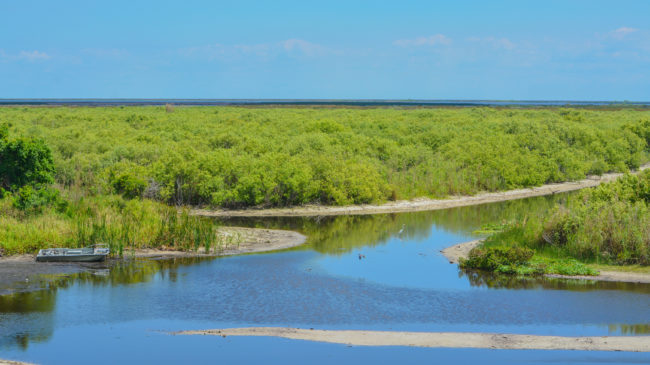In recent years, toxic blue-green algae blooms have plagued Florida, causing declarations of a state of emergency in both 2016 and 2018. If Florida were to experience another severe outbreak in the near future, it could wreak further devastation on the state’s tourism industry, which is already struggling amid the COVID-19 pandemic. In an effort to rein in nutrient pollution that causes the blooms, Florida Gov. Ron DeSantis recently signed two major water quality bills into law.
Blue-green algae blooms affect freshwater bodies throughout Florida, but Lake Okeechobee and the wider Everglades region present the largest and most complex environmental challenge. Over a century of misguided drainage projects in the region has altered the natural flow of water into and out of Lake Okeechobee. As a result, large quantities of water carrying algae and excess nutrients are discharged from the lake to the coast through the Caloosahatchee and St. Lucie rivers.
A massive restoration effort is underway to reduce the need for these harmful discharges and provide additional water treatment, but tackling Florida’s water quality issues requires the state to address sources of nutrient pollution directly. The two bills signed by Gov. DeSantis are a strong first step in that effort.
One of the bills, HB 1091, increases penalties for sewage spills which will provide stronger incentives for municipal governments to upgrade aging sewer infrastructure. Sewage spills are a significant source of nutrient pollution that contributes to algal blooms. Nearly 23,000 spills across the state released 1.6 billion gallons of wastewater into the environment between 2009 and 2019—over 370 million gallons of which were completely untreated. Approximately 980 million gallons of this wastewater, including 220 million gallons of raw sewage, flowed into Florida’s waterways.
The other bill, SB 712, incorporates several recommendations from the governor’s Blue-Green Algae Task Force (which has been meeting for the last year) and addresses a wide range of nutrient pollution sources including wastewater, septic systems, and agriculture.
Regarding wastewater, SB 712 creates a wastewater grant program that will provide funding for sewer infrastructure projects and efforts to upgrade or convert septic systems. If the Department of Environmental Protection determines that wastewater contributes at least 20 percent of nutrient pollution in an area, the bill requires local governments to develop wastewater treatment plans in order to meet established water quality standards.
The new law also transfers oversight of septic systems from the Department of Health (FDOH) to the Department of Environmental Protection (FDEP). This change is significant because in the past FDOH oversight focused primarily on pathogen reduction rather than preventing nutrient pollution. Similar to wastewater treatment plans, local governments will be required to develop septic remediation plans in areas where septic systems contribute at least 20 percent of nutrient pollution.
Agriculture is the largest source of nutrient pollution in the Lake Okeechobee watershed. The primary method for reducing nutrient runoff is the adoption of agricultural “Best Management Practices” (BMPs) developed by the Florida Department of Agriculture and Consumer Services. Producers in protected watersheds are required to either implement BMPs or conduct monitoring to demonstrate compliance with water quality standards.
SB 712 strengthens the BMP program by requiring onsite inspections to ensure that BMPs are achieving nutrient reduction goals. Moreover, producers enrolled in BMPs are now required to provide regulators with detailed documentation of fertilizer use.
Many of the regulatory provisions included in SB 712 will cost at least $1 million over the first five years of implementation and will, therefore, require legislative ratification each year. State budget cuts in response to the COVID-19 pandemic, recession, and decreased tax revenue could jeopardize these provisions and other funding intended for wastewater projects.
Although these bills make substantive changes to Florida water policy, environmental groups have criticized the legislation for doubling-down on failed regulatory schemes and not going far enough to target agricultural nutrient sources. Regardless of their shortcomings, these reforms are still a strong step toward addressing Florida’s water quality crisis. However, legislators shouldn’t close the book on Everglades restoration––there is still plenty of work to be done.

